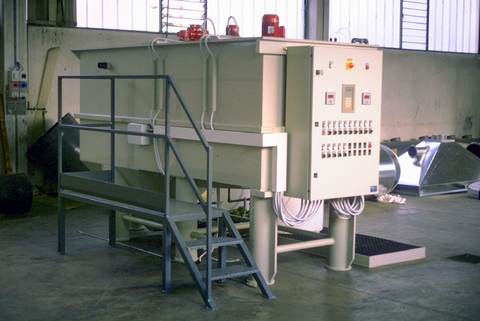FENTON
Industrial wastes treatment by means of the reactive FENTON

Industrial wastes are, in many cases, characterised by a remarkable content of organic matter (COD).
Nevertheless, in order to achieve suitable characteristics for biological treatment, some problems must be solved, related to the following factors:
- presence of non biodegradable organic matter, which leads to low BOD/COD ratios;
- presence of some compounds which, above critic concentration, have toxic or hinibitory effects on the biomass;
- lack of substances necessary for the bacterical flora growing (like nutrients);
- large excursions of the waste water characteristics both in qualitative and quantitative terms
Since many factories discharges their waste waters in municipal sewer, almost in any case chemical-physical or chemical pre-treatment are required.
These treatments are in general characterised by the following positive aspects:
- fast starting with respect to traditional biological processes (they are suitable also for occasional or seasonal treatment needs)
- no sensibility to toxic compounds (which instead can be removed)
- simplified operation and low sensibility to external variables (e.g. climate)
On the other hand, chemical treatments are characterised by the following main drawbacks: cost of chemicals, cost for sludge disposal, environmental
risks dealing with the possibility of chemical casual reversals, possible supply of toxic substances due to the use of chemicals.
Then, pre-treatment in biological systems must be carefully evaluated, in terms of cost-benefits.
This treatment consists of a strong chemical oxidation, carried out in acidic conditions by means of hydrogen peroxide and ferrous salts.
This reagents can destroy with high efficiency haromatic and chromofor groups.
In particular this process is suitable as a pre-treatment for waste water characterised by an initial COD concentrations of some thousands of mg/l,
for the removal of low degradable organic compounds like: non-ionic surfactants, aniline and its compounds (which, during biological processes,
can lead to coloured oxidation compounds), phenol compounds, etc.
The classical treatment scheme, for the Fenton process, consists of the following steps: omogeneization, chemical oxidation (e.g. with sulfuric acid, ferrous
sulphate, hydrogen peroxide), neutralization (e.g. lime), flocculation (e.g. with anionic polyelettrolite) and sedimentation.
Besides many different industrial sectors have been considered: detergents production, textile factories, metal working facilities, etc.
Finally, the waste waters show significant variations of flowrate and composition also within the same factory.
The research has shown that industrial waste water pre-treatment by means of the Fenton process, even if more expensive (due to relatively high
operating costs) with respect to more conventional chemical-physical processes, in many cases has important advantages and can also be used to
upgrade existing plants.
Among the main advantages, the following can be mentioned:
- operating flexibility; minimum space requirements
- clear identification of operating costs
- applicability to waste waters characterised by variable composition and flowrate
- simple design sign criteria
Plant’s description
The process schema, common to all kinds of plants, which use the Fenton reactive is syntetized in two leading phases:
- the oxitation phase in which there is the distruction of the organic substances
- the sedimentation phase in which the sludges are separated from the treated water
This process is realized in a plant in which the most important components consist of :
- a preliminary homogenisation basin
- a reaction (oxidation) basin
- a neutralization basin
- a flocculation basin
- a final settler
The operative cycle of the treatment include (after the homogeneisation) the addiction of hydrogen peroxide and ferrous salts into the waste water in the
oxidation basin; the dosing of both the reagents is keeped constant at fixed rates, connected with the predetermined quantity of polluted matter.
The oxidation reaction happens at acid pH, obtained by dosing of sulfuric acid.
After the oxidation treatment the water is neutralised by means of lime to reach pH 8.5 / 9.
Than, after having added some polyelectrolite, the water runs into the settler, where the sludge is separated from the treated water,
which can go to the sewer or to a next biological plant.
In the most cases the treatment cycle is continuous; in some situations, due to the reduced volumes of waste water to be treated, the process can be
discontinuous.
The typologies of the industrial waste waters that can use the reactive Fenton come from:
- dyeing industries
- wool factories
- metals technical industries
- chemical industries